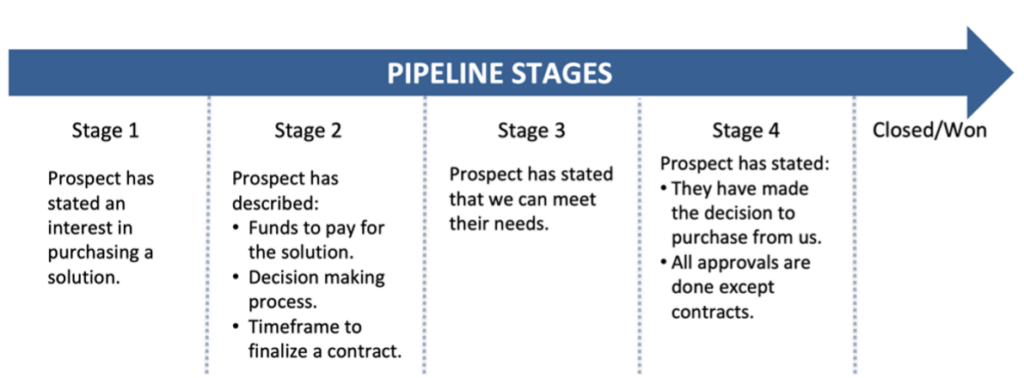Is Your Pipeline
Meaningless?

Part 1 in our Executive Summit Series. Make your pipeline a useful indicator of sales success.
Do you find your sales pipeline to be a meaningless statistic? Many early-stage companies find that their pipeline has a poor correlation to revenue. As they grow, they discover that pipeline growth rate is much larger than the revenue growth rate, or the percentage of pipeline closed each quarter is less than 15%. This leads to uncomfortable board conversations and promises that despite a poor quarterly outcome, pipeline statistics are on the up and up. This talk track gets old after a couple of quarters and indicates a larger problem – that you could be measuring your pipeline the wrong way. You could be tracking your sales team’s progress versus the buyer’s!
Look at these pipeline definitions/stages. Are yours similar?

Many companies use a similar pipeline. Let’s look at what is being tracked: Lead, Qualified, Survey Demo, etc. What do these have in common? They are tracking the motions of the seller, not the buyer. The seller has led, qualifies, demos, and proposes. Why are we tracking the seller’s actions? The seller is not making the decision or paying for the purchase! We need to track the buyer’s actions. More specifically we need to track the buyer actions related to their increased preference to purchase from us.
How do we do this? We create rules that are based upon the buyer’s demonstrated preference for our solution as measured by their words or actions. We refer to these as “Customer Verifiable Outcomes”. A good example is: “Buyer has stated they have selected our solution for purchase”. Note that the buyer is the subject of the sentence and the action they have taken to show increased commitment is that they have “stated they have selected our solution for purchase”. Now we see where the customer is in their “buying cycle” versus our “sales cycle”. We create rules for each pipeline stage that must be satisfied to move to the next pipeline stage. Here is a simplified example:

With this approach, you will have a pipeline that is statistically valid, with a much better correlation between pipeline and revenue. Be forewarned that when you make the initial switch, you will see your pipeline shrink or “move to the left” as your salespeople move leads to earlier stages. Remember that it is more important to have an accurate pipeline than to have an inflated pipeline. Imagine a sales process where time is spent strategizing the next steps to win customers, not merely understanding what’s real. Here, the pipeline is based on concrete buyer data pulled from buyer signals, not the gut feeling of the salesperson, making it an accurate measure of your pipeline progress.
TechCXO is founded on the belief that high-potential companies can benefit from proven interim of fractional executives whom they might not otherwise be able to access, afford, or because they are not needed full time. Learn more about TechCXO’s proven partners at TechCXO.com.
Contact information:
Brad Milner, TechCXO, brad.milner@techcxo.com

